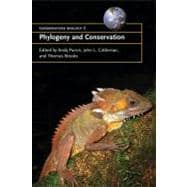
Note: Supplemental materials are not guaranteed with Rental or Used book purchases.
Purchase Benefits
What is included with this book?
| 1. Phylogeny and conservation Andy Purvis, John L. Gittleman and Thomas M. Brooks | |
| Part I. Units and Currencies: 2. Molecular phylogenetics for conservation biology Elizabeth A. Sinclair, Marcos Pé | |
| rez-Losada and Keith A. Crandall | |
| 3. Species: demarcation and diversity Paul-Michael Agapow, 4. Phylogenetic units and currencies above and below the species level John C. Avise | |
| 5. Integrating phylogenetic diversity in the selection of priority areas for conservation: does it make a difference? Ana S. L. Rodrigues, Thomas M. Brooks and Kevin J. Gaston | |
| 6. Evolutionary heritage as a metric for conservation Arne Ø | |
| . Mooers, Stephen B. Heard and E. Chrostowski | |
| Part II. Inferring Evolutionary Processes: 7. Age and area revisited: identifying global patterns and implications for conservation Kate E. Jones, Wes Sechrest and John L. Gittleman | |
| 8. Putting process on the map: why ecotones are important for preserving biodiversity Thomas B. Smith, Sassan Saatchi, Catherine Graham, Hans Slabbekoorn and Greg Spicer | |
| 9. The oldest rainforests in Africa: stability or resilience for survival and diversity? Jon C. Lovett, Rob Marchant, James Taplin and Wolfgang Kü | |
| per | |
| 10. Late Tertiary and Quaternary climate change and centres of endemism in the southern African flora Guy F. Midgley, Gail Reeves and C. Klak | |
| 11. Historical biogeography, diversity and conservation of Australia's tropical rainforest herpetofauna Craig Moritz, Conrad Hoskin, Catherine H. Graham, Andrew Hugall and Adnan Moussalli | |
| Part III. Effects of Human Processes: 12. Conservation status and geographic distribution of avian evolutionary history Thomas M. Brooks, J. D. Pilgrim, Ana S. L. Rodrigues and Gustavo A. B. da Fonseca | |
| 13. Correlates of extinction risk: phylogeny, biology, threat and scale Andy Purvis, Marcel Cardillo, Richard Grenyer and Ben Collen | |
| 14. Mechanisms of extinction in birds: phylogeny, ecology and threats Peter M. Bennett, Ian P. F. Owens, Daniel Nussey, Stephen T. Garnett and Gabriel M. Crowley | |
| 15. Primate diversity patterns and their conservation in Amazonia José | |
| M. Cardoso da Silva, Anthony B. Rylands, José | |
| S. Silva Jú | |
| nior, Claude Gascon and Gustavo A. B. da Fonseca | |
| 16. Predicting which species will become invasive: what's taxonomy got to do with it? Julie Lockwood | |
| Part IV. Prognosis: 17. Phylogenetic futures after the latest mass extinction Sean Nee | |
| 18. Predicting future speciation Timothy G. Barraclough and T. Jonathan Davies. |
The New copy of this book will include any supplemental materials advertised. Please check the title of the book to determine if it should include any access cards, study guides, lab manuals, CDs, etc.
The Used, Rental and eBook copies of this book are not guaranteed to include any supplemental materials. Typically, only the book itself is included. This is true even if the title states it includes any access cards, study guides, lab manuals, CDs, etc.